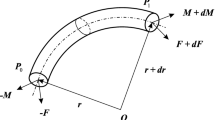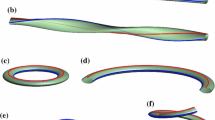Abstract
Methods are presented for obtaining exact analytical representations of supercoiled equilibrium configurations of impenetrable elastic rods of circular cross-section that have been pretwisted and closed to form rings, and a discussion is given of applications in the theory of the elastic rod model for DNA. When, as here, self-contact is taken into account, and the rod is assumed to be inextensible, intrinsically straight, transversely isotropic, and homogeneous, the important parameters in the theory are the excess link Δℒ (a measure of the amount the rod was twisted before its ends were joined), the ratio ω of the coefficients of torsional and flexural rigidity, and the ratio d of cross-sectional diameter to the length of the axial curve C. Solutions of the equations of equilibrium are given for cases in which self-contact occurs at isolated points and along intervals. Bifurcation diagrams are presented as graphs of Δℒ versus the writhe of C and are employed for analysis of the stability of equilibrium configurations. It is shown that, in addition to primary, secondary, and tertiary branches that arise by successive bifurcations from the trivial branch made up of configurations for which the axial curve is a circle, there are families of equilibrium configurations that are isolas in the sense that they are not connected to bifurcation branches by paths of equilibrium configurations compatible with the assumed impenetrability of the rod. Each of the isolas found to date is connected to a bifurcation branch by a path which, although made up of solutions of the governing equations, contains regions on which the condition of impenetrability does not hold.
Similar content being viewed by others
References
I. Tobias, D. Swigon, and B.D. Coleman, Elastic stability of DNA configurations: I. General theory. Phys. Rev. E 61 (2000) 747–758.
B.D. Coleman, D. Swigon, and I. Tobias, Elastic stability of DNA configurations: II. Supercoiling of miniplasmids. Phys. Rev. E 61 (2000) 759–770.
D. Swigon, Configurations with self-contact in the theory of the elastic rod model for DNA, Doctoral Dissertation, Rutgers University, New Brunswick (1999).
G. Kirchhoff, Ñber das Gleichgewicht und die Bewegung eines unendlich dünen elastischen Stabes. J. Reine angew. Math. (Crelle) 56 (1859) 285–313.
A. Clebsch, Theorie der Elasticität Fester Körper, Teubner, Leipzig (1862).
G. Kirchhoff, Vorlesungen über mathematische Physik, Mechanik, Vol. 28, Teubner, Leipzig (1876).
E.H. Dill, Kirchhoff's theory of rods. Arch. Hist. Exact Sci. 44 (1992) 1–23.
R. Courant, Differential and Integral Calculus, Vol. II, Blackie, London (1936).
F.B. Fuller, The writhing number of a space curve. Proc. Natl. Acad. Sci. USA. 68 (1971) 815–819.
J.H. White, An introduction to the geometry and topology of DNA structure. In: Mathematical Methods for DNA Sequences, CRC, Boca Raton, Florida (1989), pp. 225–253.
G. Calugareanu, Sur les classes d'isotopie des noeuds tridimensionnels et leurs invariants. Czechoslovak Math. J. 11 (1961) 588–625.
J.H. White, Self-linking and the Gauss integral in higher dimensions. Amer. J. Math. 91 (1969) 693–728.
R.A. Litherland, J. Simon, O. Durumeric, and E. Rawdon, Thickness of knots. Topology Appl. 91 (1999) 233–244.
M. Le Bret, Twist and writhing in short circular DNAs according to first-order elasticity. Biopolymers 23 (1984) 1835–1867.
L.D. Landau and E.M. Lifshitz, Theory of Elasticity, Pergamon Press, Oxford (1959).
I. Tobias, B.D. Coleman, and W. Olson, The dependence of DNA tertiary structure on end conditions: Theory and implications for topological transitions. J. Chem. Phys. 101 (1994) 10990–10996.
B.D. Coleman, I. Tobias, and D. Swigon, Theory of the influence of end conditions on self-contact in DNA loops. J. Chem. Phys. 103 (1995) 9101–9109.
D. Swigon, B.D. Coleman, and I. Tobias, The elastic rod model for DNA and its application to the tertiary structure of DNA minicircles in mononucleosomes. Biophys. J. 74 (1998) 2515–2530.
B.D. Coleman, E.H. Dill, M. Lembo, Z. Lu, and I. Tobias, On the dynamics of rods in the theory of Kirchhoff and Clebsch. Arch. Rational Mech. Anal. 121 (1993) 339–359.
J.W. Milnor, Topology from the Differentiable Viewpoint, 2nd edn, The University Press of Virginia, Charlotesville (1969).
P.J. Holmes, G. Domokos, J. Schmitt, and I. Szeberényi, Constrained Euler buckling: An interplay of computation an analysis. Comp. Meth. in Appl. Mech. and Eng. 170 (1999) 175–207.
W.F. Pohl, The self-linking number of a closed space curve. J. Math. Mech. 17 (1968) 975–985.
P.J. Hagerman, Flexibility of DNA. Annu. Rev. Biophys. Biophys. Chem. 17 (1988) 265–286.
J.M. Schurr, B.S. Fujimoto, P. Wu, and L. Song, Fluorescence studies of nucleic acids: Dynamics, rigidities, and structures. In: J.R. Lakowicz (ed.), Topics in Fluorescence Spectroscopy, Vol. 3: Biochemical Applications, Plenum Press, New York (1992).
D.S. Horowitz and J.C. Wang, Torsional rigidity of DNA and length dependence of the free energy of DNA supercoiling. J. Mol. Biol. 173 (1984) 75–91.
C. Bouchiat and M. Mezard, Elasticity model of supercoiled DNA molecule. Phys. Rev. Lett. 80 (1998) 1556–1559.
T. R. Strick, J.-F. Allemand, D. Bensimon, A. Bensimon, and V. Croquette, The elasticity of a single supercoiled DNA molecule. Science 271 (1996) 1835–1837.
P.J. Heath, J.B. Clendenning, B.S. Fujimoto, and J.M. Schurr, Effect of bending strain on the torsion elastic constant of DNA. J. Mol. Biol. 260 (1996) 718–730.
E.E. Zajac, Stability of two planar loop elasticas. J. Appl. Mech. 29 (1962) 136–142.
G. Domokos, A group-theoretic approach to the geometry of elastic rings. J. Nonlinear Sci. 5 (1995) 453–478.
G. Domokos and T.J. Healey, Hidden symmetry of global solutions in twisted elastic rings. J. Nonlin. Sci. (October 2000), accepted.
D.M. Stump, W.B. Fraser, and K.E. Gates, The writhing of circular cross-section rods: From undersea cables to DNA supercoils. Proc. Roy. Soc. London A 454 (1998) 2123–2156.
B. Fain and J. Rudnick, Conformations of closed DNA. Phys. Rev. E 60 (1999) 7239–7252.
Author information
Authors and Affiliations
Rights and permissions
About this article
Cite this article
Coleman, B.D., Swigon, D. Theory of Supercoiled Elastic Rings with Self-Contact and Its Application to DNA Plasmids. Journal of Elasticity 60, 173–221 (2000). https://doi.org/10.1023/A:1010911113919
Issue Date:
DOI: https://doi.org/10.1023/A:1010911113919




